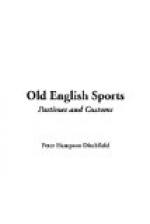I fear that our old writer must have made a great mistake if he imagined that the Saxons ever played cricket, and I believe that the word was not known before the sixteenth century. In the records of Guildford we find that a dispute arose about the enclosure of a piece of land in the time of Elizabeth; and in the suit that arose one John Derrick stated in his evidence that he knew the place well “for fifty years or more, and that when he was a scholar in the free school at Guildford he and several of his companions did run and play there at cricket and other plays.” Also in Cotgrave’s French Dictionary, published in 1611, the word crosse is translated “a cricket-staff, or the crooked-staff wherewith boys play at cricket.”
In the eighteenth century allusions to the game become more frequent, although it was still a boy’s game. It had its poet, who sang—
“Hail, cricket, glorious,
manly, British game,
First of all sports,
be first alike in fame.”
It had its calumniators, who said that it “propagated a spirit of idleness” in bad times, when people ought to work and not play, and that it encouraged gambling. But the game began to prosper, and several noted men, poets and illustrious statesmen, recall the pleasurable memories of their prowess with the bat and ball. In a book of songs called Pills to purge Melancholy, published in 1719, we find the verse—
“He was the prettiest
fellow
At football or at cricket:
At hunting chase or
nimble race
How featly he could
prick it.”
In the early part of the eighteenth century the game was in a very rudimentary condition, very different from the scientific pastime it has since become. There were only two wickets, a foot high and two feet apart, with one long bail at the top. Between the wickets there was a hole large enough to contain the ball, and when the batsman made a run, he had to place the end of his bat in this hole before the wicket-keeper could place the ball there, otherwise he would be “run out.”
The bat, too, was a curved, crooked arrangement very different from our present weapon. The Hambledon Club, in Hampshire, which has produced some famous players, seems to have been mainly instrumental in reforming and improving the game. Its members introduced a limit to the width of the bat, viz., four and a quarter inches—the standard still in force—in order to prevent players, such as a hero from Reigate, bringing bats as wide as the wicket. In 1775 they wisely introduced a middle stump, as they found the best balls harmlessly flying between the wide wickets. It was feared lest this alteration would shorten the game too much, but it does not seem to have had that effect, as in an All England match against the Hambledon Club, two years later, one Aylward scored 167 runs, and stayed in two whole days. England owes much to the old Club at Hambledon for the improvements which it wrought in the game, which has become our great national pastime.




